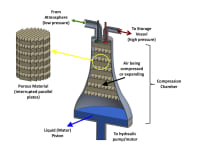The major challenge in integrating wind energy into the electrical grid is that the resource is intermittent and unpredictable so that energy is always available. With an energy storage system integrated with a wind turbine, surplus energy can be stored and then regenerated when demand is higher.
In the proposed Compressed Air Energy Storage (CAES) system (graphics 1) energy is stored prior to electricity generation, eliminating the need and losses associated with generating electricity twice. This also allows the electrical generator and transmission lines to be downsized for mean power instead of peak power. This can be a significant cost-saving for off-shore installations as their capacities are currently under-utilized by over 50%. Further savings comes from replacing a failure prone mechanical gearbox in the nacelle with a hydraulic pump, and installing the rest at the ground/sea level. Wind energy capture can be maximized by controlling the nacelle hydraulic pump. By maintaining the generator at constant speed regardless of wind speed, a cost effective induction generator can be used with no expensive power conditioning electronics.
In a “conventional” CAES, excess electricity is used to compress ambient air to up to 80bar into underground caverns for storage. The air is heated during compression but during storage it cools. When electricity is needed, the compressed air is mixed with natural gas and burned in a gas turbine to generate work and electricity. This process is inefficient and emits carbon dioxide. Moreover, as compressed air is stored and retrieved, pressure varies greatly. As very low pressure air is not very useful, the minimum pressure allowed is 50bar. This greatly reduces (by 40%) the energy storage capacity for a given volume as the air at 50bar is unused.
Our system has two key innovations compared to a conventional CAES. First, we use a compressor/expander that compresses air from atmospheric pressure to over 200bar near-isothermally. This makes compressing air to store and and expanding air to retrieve energy efficient and with no need for a natural gas turbine. It is accomplished using a liquid piston in which compression is by pumping water into a chamber, and the water column compresses the air above it (graphics 2). The liquid, besides being a good seal, can flow through tortuous route such as a porous medium inserted into the chamber. This allows heat transfer to the porous medium quickly via significantly increased surface area. The reverse occurs during expansion when heat is transferred from the porous medum into the expanding air. Experiments confirm that this increase in heat transfer can make the compressor/expander 10 times more powerful (or operate faster) without sacrificing efficiency (graphics 3).
Second, the proposed system uses an “open accumulator” architecture in which the storage vessel contains both compressed air and water. This allows the pressure in the vessel to be constant by removing and adding water as air is added or retrieved, making all the compressed air useable. By this and by increasing the pressure to 210bar, the energy capacity is increased by 550%.
Video
Like this entry?
-
About the Entrant
- Name:Perry Li
- Type of entry:teamTeam members:Perry Li, Terry Simon, Jim Van de Ven, Mohsen Saadat, Chao Zhang
- Software used for this entry:Matlab/Simlink, Ansys/Fluent, COMSOL
- Patent status:patented








